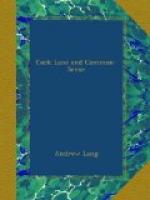The trial, as Sir Walter says, in his dedication to the Bannatyne Club, ‘involves a curious point of evidence,’ a piece of ’spectral evidence’ as Cotton Mather calls it. In another dedication (for there are two) Scott addresses Sir Samuel Shepherd, remarking that the tract deals with ’perhaps the only subject of legal inquiry which has escaped being investigated by his skill, and illustrated by his genius’. That point is the amount of credit due to the evidence of a ghost. In his preface Sir Walter cites the familiar objection of a learned judge that ’the ghost must be sworn in usual form, but in case he does not come forward, he cannot be heard, as now proposed, through the medium’ (medium indeed!) ’of a third party’. It seems to be a rule of evidence that what a dead man said may be received, on the report of the person with whom he communicated. A ghost is a dead man, and yet he is deprived, according to the learned judge’s ruling, of his privilege. Scott does not cite the similar legend in Hibernian Tales, the chap book quoted by Thackeray in his Irish Sketch-book. In that affair, when the judge asked the ghost to give his own evidence: ’Instantly there came a dreadful rumbling noise into the court—“Here am I that was murdered by the prisoner at the bar"’. The Hibernian Tales are of no legal authority, nor can we give chapter and verse for another well-known anecdote. A prisoner on a charge of murder was about to escape, when the court observed him looking suspiciously over his shoulder. ‘Is there no one present,’ the learned judge asked in general, ‘who can give better testimony?’ ‘My lord,’ exclaimed the prisoner, ’that wound he shows in his chest is twice as big as the one I gave him.’ In this anecdote, however, the prisoner was clearly suffering from a hallucination, as the judge detected, and we do not propose to consider cases in which phantasms bred of remorse drove a guilty man to make confession.
To return to Scott; he remarks that believers in ghosts must be surprised ’to find how seldom in any country an allusion hath been made to such evidence in a court of justice’. Scott himself has only ‘detected one or two cases of such apparition evidence,’ which he gives. Now it is certain, as we shall see, that he must have been acquainted with several other examples, which did not recur to his memory: the memory of 1831 was no longer that of better years. Again, there were instances of which he had probably never possessed any knowledge, while others have occurred since his death. We shall first consider the cases of spectral evidence (evidence that is of a dead man’s ghost, not of a mere wraith) recorded by Sir Walter, and deal later with those beyond his memory or knowledge. {250} Sir Walter’s first instance is from Causes Celebres, (vol. xii., La Haye, 1749, Amsterdam, 1775, p. 247). Unluckily the narrator, in this collection, is an esprit fort, and is assiduous in attempts to display his wit. We have not a plain unvarnished tale, but something more like a facetious leading article based on a trial




